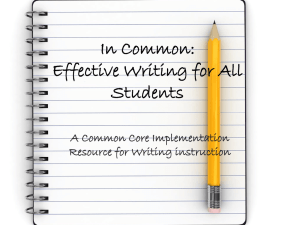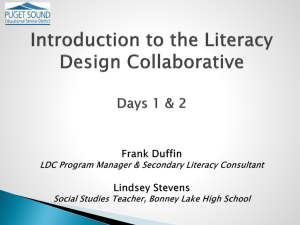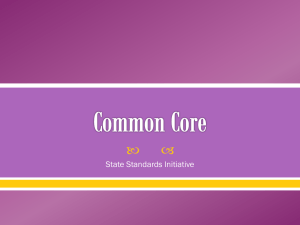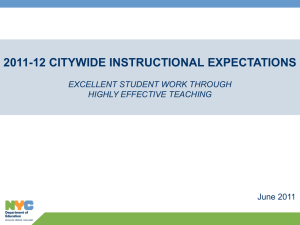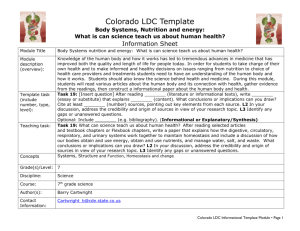File - Eng/LA Teacher leader Network
advertisement
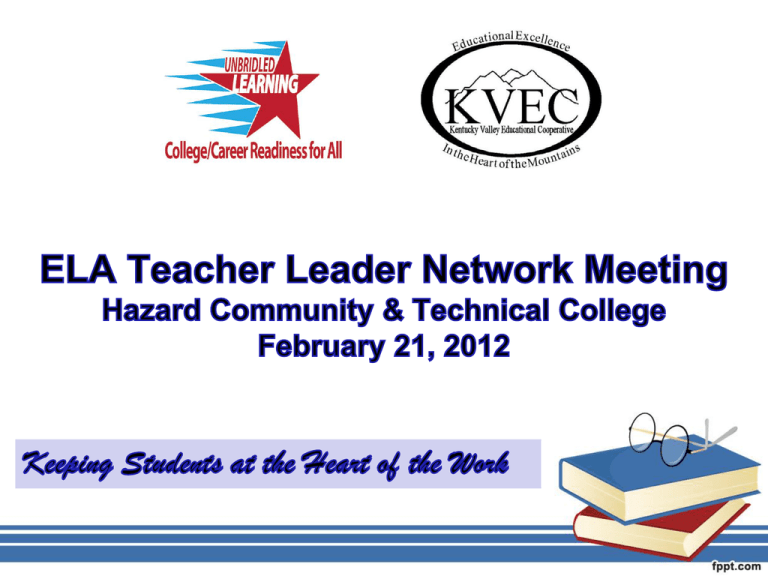
Your Facilitators for Today Carole Mullins Regional Network Content Specialist, English/LA Mary McCloud KVEC Literacy Consultant Linda Holbrook KDE Literacy Consultant Jennifer Carroll Instructional Supervisor, Wolfe County Schools AGENDA • • • • • • • • • • WELCOME Today’s Learning Targets Plan-Do-Review Reflection Breakout Sessions Module Creator KCAS 3 Modes of Writing and LDC Seven Strategies of Assessment for Learning LDC Module Rubric: Taking A Harder Look Informational/Explanatory Writing: Introduction to Task 11, 12 &14 Grade Level Groups: Resources & First Steps in Developing an Informational/Explanatory LDC Task Grade Level Specific KCAS Standards and CHETL LDC Rubric for Informational/Explanatory Task 11, 12 & 14 Connections: Standards-CHETL-Assessment-Leadership Leadership: Personal Goal Setting Extended Learning and Closing Today’s Learning Targets • I can use module creator to create and/or publish LDC modules. • I can make connections between LDC and the KCAS Three Modes of Writing. • I can articulate the Seven Strategies of Assessment for Learning and describe how they relate to components of HETL, especially rigor. • I can explain the criteria of informational/explanatory writing and it’s connection to CHETL. • I can begin the process of creating an informational/explanatory teaching task. • I can set personal goals and make an action plan to advance the vision of 21st century learning PLAN-DO-REVIEW Share your Plan-Do-Review work since our last meeting. Guiding Questions 1. What information did you share? 2. How did you share the information? 3. What worked? 4. What concerns do you still have? Three 50 Minute Breakout Sessions K-5 Session #1: Room 1 9:30-10:20 Module Creator 10:30-11:20 Session #2: Room 2 6-8 KCAS 3 Modes of Writing and LDC 11:30-12:20 Session #3: Room 3 9-12 7 Strategies of Assessment for Learning 12:20 – 1:05 p.m. Plan-Do-Review Take a moment and add notes to your P-D-R Guiding Questions 1. What information will you share? 2. How will you share the information? 3. What concerns do you still have? We Must Remember That... • The Literacy Design Collaborative work is a 2-4 week module. • It is a teaching and learning opportunity with a prompt. • It is COACHED INSTRUCTION FROM THE BEGINNING TO THE END. • It is NOT just a response to a prompt. Be Comfortable With PRODUCTIVE STRUGGLE! • LDC is a very constructivist framework. In addition to the guaranteed hardwiring of standards, a strength of the design is that it allows teachers to bring their expertise and knowledge to it. • But this very strength also causes some discomfort. Perceptions and past experiences must sometimes be revised in the process, and gaps in knowledge addressed. 10 Taking A Harder Look… Module Rubric: Taking a Harder Look… Guiding Questions for Conversation • Review Page 2 of the Handout • Highlight words you think are the most important 12 Think Aloud How are a culture’s values reflected in literature? After reading a version of Cinderella from a different culture (s) write an essay that discusses the similarities and differences between each story and evaluates how they reflect which values are most important in that culture(s). Be sure to support your position with evidence from the texts. Written as an argumentation 13 Think Aloud After reading “The Tell-Tale Heart”, and other works by Edgar Allan Poe, write a report that defines tone and explains how Poe established tone in the text. Readings included biographical information and other commentaries about Poe’s life and works. Written as informational 14 Think Aloud What are the qualities of a good reader and a good writer? After reading Vladimir Nabokov’s essay “Good Readers and Good Writers” and other essays, write an essay that addresses the question and support your position with evidence from the text. Written as argumentation 15 Think Aloud What makes a relationship enduring and mutually beneficial to both individuals? After reading ‘Romeo and Juliet’ and various informational texts about different types of relationships and marriage, write an essay that addresses the question and support your position with evidence from the text(s). Be sure to acknowledge competing views. Written as argumentation 16 Template Tasks All LDC tasks require students to: Read, analyze, and comprehend texts as specified by the common core Write products as specified by the common core (focusing on argumentation, informational/explanatory, and narrative) Apply common core literacy standards to content (ELA, social studies, and/or science) The tasks are designed to ensure that students receive literacy and content instruction in rigorous academic reading and writing tasks that prepare them for success in college by the end of their high school career. Template Tasks Teachers use additional “plug and play” flexibility within the template to adjust: • Task level: Select level 1, 2, or 3 task • Reading requirements: Vary text complexity, genre, length, familiarity, etc. • Writing demands: Vary product, length, etc. • Pacing requirements: Vary workload and time allowed to complete Basic Task Design Process 3. Choose Texts Students Will Read 1. Choose Your Template Task Your template task can: n Be argumentation, information, or narrative. n Use an essential question or an “after researching” task. n Call for students i to develop a definti on, a description, a procedural-sequential piece, a synthesis, an analysis, a comparison, or a discussion of cause and effect. 2. Choose Your Topic Your choice should: n Address a major issue in your discipline (big enough to be a good investment of 2 to 4 weeks of class time). n Fit the state and local standards for which you are responsible. n Make sense as a subject to teach during the weeks you are planning to schedule this task. 5. Create Your Teaching Task Your prompt should: n Use the exact wording of the template. n Use your topic, reading texts, and writing text choices l to fil in the blanks and brackets. n Be both challenging and f easible for students, with a balance of reading demands and writing demands that works well for the intended grade and content. n Require sustained writing and effective use of ideas and evidence from the reading texts. n Be built out for students by adding introductory background statement and ending with extension if applicable. Your choices should: n Address your topic. n Be short enough to allow close reading and careful analysis. n Use and develop academic understanding and vocabulary. n Where possible, include models of the kind of text students will be writing. Or, you can specify a topic and assign students to research the issue to select texts that address the issue. 4. Choose Texts Students Will Write Your choice should: n Be a good fit for your topic, template task, and students. n Where possible, resemble writing students may need to do in adult life (for example, make an argument in a letter to the editor, or explain a process in a memo to a colleague.) Revised LDC Guidebook: Page 31 24 | Meeting Common Literacy Standar ds in Your Classroom: The Literacy Design Collaborativ e Guide for Teachers LDC Task Requirements WHAT IS REQUIRED? § § § § List the exact Common Core State Standards for the template task. § List the reading texts for the prompt or describe how students will be guided to select appropriate texts. § § Provide a background statement that introduces the prompt to students. § Use the exact rubric for the template task. Add appropriate state content standards. Provide source information for the standards you use. Fill in the template task, completing all the blanks but not altering the other template wording. If an extension activity is included, provide an activity in which students share or apply what they have learned with a real-world audience or through a hands-on project. (The extension may also be omitted.) LDC Task Flexibility WHAT CAN BE CHANGED OR ADDED? § You can also include appropriate grade-level Common Core State Standards. § You choose which texts students will read, the content they will study, and the writing product they will create. In choosing, consider requirements set by your state, district, or school. § You decide whether to include the Level 2 and Level 3 portions of the template task and whether to include extension sections. A Great LDC Teaching Task • Addresses content essential to the discipline, inviting students to engage deeply in thinking and literacy practices around that issue. • Makes effective use of the template task’s writing mode (argumentation, information/explanation, or narrative). • Selects reading texts that use and develop academic understanding and vocabulary. A Great LDC Teaching Task • Designs a writing prompt that requires sustained writing and effective use of ideas and evidence from the reading texts. • Establishes a teaching task that is both challenging and feasible for students, with a balance of reading demands and writing demands that works well for the intended grade and content. KCAS Writing Standard #2 Anchor Standard Write informative/explanatory texts to examine and convey complex ideas and information clearly and accurately through the effective selection, organization, and analysis of content. Informational/Explanatory Writing • Conveys information accurately • Serves one or more closely related purposes: To increase reader’s knowledge about something To help readers better understand a procedure or process To provide readers with an enhanced comprehension of a concept (Appendix A) 25 Informational/Explanatory Writing • Students draw from what they already know • Students draw from primary and secondary sources “With practice, students become better able to develop a controlling idea and a coherent focus on a topic and more skilled at selecting and incorporating relevant facts, examples, and details into their writing.” (Appendix A) 26 Arguments and Explanations: Each Has a Different Aim: • Arguments seek to make people believe that something is true or to persuade people to change their beliefs or behavior. • Explanations…start with the assumption of truthfulness and answer questions about why or how. Their aim to make the reader understand rather than persuade him or her to accept a certain point of view.” (Appendix A) 27 Organizational Structures for Informative Writing • • • • • • • Definition Description Procedural-Sequential Synthesis Analysis Comparison Cause/Effect Informational/Explanatory Definition Template Task 11 • Task 11:After researching________ (informational texts)on________ (content),write a________ (report or substitute) that defines ________ (term or concept) and explains________ (content). Support your discussion with evidence from your research. L2 What ________ (conclusions or implications) can you draw? (Informational or Explanatory/Definition) Task 11 ELA Example: • After researching articles on modernism in American literature, write a report that defines “modernism” and explains its impact on contemporary arts. Support your discussion with evidence from your research. (Informational or Explanatory/Definition) Informational/Explanatory Definition Template Task 12 • Task 12:[Insert question] After reading________ (literature or informational texts),write a/an________ (essay, report, or substitute) that defines________ (term or concept) and explains________ (content). Support your discussion with evidence from the text(s). L2 What ________ (conclusions or implications) can you draw?(Informational or Explanatory/Definition) Task 12 ELA Example: • What is a “metaphor”? After reading The House on Mango Street and drawing from other works you’ve read this year, write an essay that defines “metaphor” and explains how authors use it to enhance their writing. Support your discussion with evidence from the texts. (Informational or Explanatory/Definition) Informational/Explanatory Description Template Task • Task 14: [Insert question] After reading________ (literature or informational texts),write a/an________ (essay, report, or substitute) that describes________ (content) and addresses the question. Support your discussion with evidence from the text(s). (Informational or Explanatory/Description) Task 14 ELA Example: • How does Esperanza deal with her challenges as an immigrant to the United States? After reading Esperanza Rising, write an essay that describes her challenges and addresses the question. Support your discussion with evidence from the text. (Informational or Explanatory/Description) Writing Forms for LDC Tasks • Materials Needed: • List of Possible Writing Forms for LDC Tasks • Highlighter • Instructions: • Review each category and highlight those forms you have previously taught. • Review those that you haven’t taught and identify 3-5 choices that you could possibly teach. Grade Level Groups K-5: Room 2 6-8: Room 3 9-12: Main Room 2:00-2:10 p.m. Informational/Explanatory Task Connections to Grade Level KCAS • CCSS Anchor Standards are embedded within an LDC Module for Teaching Task 2.Grade level specific KCAS must be included by the teacher. • Read through the deconstructed KCAS connected to Task 11, 12 and 14 Anchor Standards for your grade level. • REMINDER: Pay close attention to the targets. They will become part of your instructional ladder). • After developing your informational/explanatory task, be sure to plan for inclusion of these learning targets/deconstructed standards within your instructional ladder. Why Are the Template Task Scoring Rubrics Important? LDC template tasks use shared rubrics (scoring guides) to decide whether student work meets expectations. One scoring guide works for all argumentation tasks, another for all informational and explanatory tasks, and a third for the narrative tasks. Shared rubrics support teacher collaboration across grades and subjects, including: Shared scoring to develop common expectations and language Joint analysis of student work Collaborative planning around instructional strategies and improvements A Quick Glance at the LDC Scoring Rubric for Informational/Explanatory Informational/Explanatory Focus Attempts to address prompt, but lacks focus or is off-task. Addresses prompt appropriately, but with a weak or uneven focus. Addresses prompt appropriately and maintains a clear, steady focus. Addresses all aspects of prompt appropriately and maintains a strongly developed focus. Argumentation Focus Attempts to address prompt, but lacks focus or is off-task. Addresses prompt appropriately and establishes a position, but focus is uneven. Addresses prompt appropriately and maintains a clear, steady focus. Provides a generally convincing position. Addresses all aspects of prompt appropriately with a consistently strong focus and convincing position. A Quick Glance at the LDC Scoring Rubric for Informational/Explanatory Informational/Explanatory Controlling Idea Attempts to establish a controlling idea, but lacks a clear purpose. Establishes a controlling idea with a general purpose. Establishes a controlling idea with a clear purpose maintained throughout the response. Establishes a strong controlling idea with a clear purpose maintained throughout the response. Argumentation Controlling Idea Attempts to establish a claim, but lacks a clear purpose. (L2) Makes no mention of counter claims. Establishes a claim. (L2) Makes note of counter claims. Establishes a credible claim. (L2) Develops claim and counter claims fairly. Establishes and maintains a substantive and credible claim or proposal. (L2) Develops claims and counter claims fairly and thoroughly. Constructing Your Own Teaching Task: Texts to Teach • Literature: novels, stories, poems, plays, • Informational texts: Newspaper articles, journal articles, primary source documents • Opinion pieces: editorials, speeches, essays on an issue • Reference works: encyclopedias, almanacs, manuals, how-to books Revised LDC Guidebook: Page 18 Revised LDC Guidebook Additional Resource Pages Task Ladder Pages: 16-31 35-37 39 42 43 45-46 Pages: 47-48 50-55 Argumentation Module Examples: Pages 66-112 5th Grade Informational Module Example: Distributed Today Your Turn! Before beginning your task development you may want to: Review the LDC development basics graphic (handout pg. 31) from earlier today. This lays out the fluid process/thinking that goes into designing a task. Take a look at the specifications (TTC Pg. 2) – the absolute requirements – for a full completed teaching task. Next, take a look at the characteristics that should be included in a great teaching task. Feel free to use the blank LDC Info/Ex template provided to you today as you begin your work. A Resource for You! Plan-Do-Review Take a moment and add notes to your P-D-R Guiding Questions 1. What information will you share? 2. How will you share the information? 3. What concerns do you still have? Extended Learning • Design an Informational/Explanatory Teaching Task (#11, 12, or 14) and bring it with you to the March meeting. Impact Logs Logs should be submitted to Carole Mullins in hard copy or via e-mail at the end of each month. 44 Making Connections Three Modes of Writing Assessment Literacy LDC Tasks 7 Strategies of Assessment for Learning KCAS Leadership Deconstructed Stds. for Informational/Explanatory Plan-Do-Review CHETL Three Modes of Writing It’s ALL about leadership! 45 OUR NEXT MEETING 46

